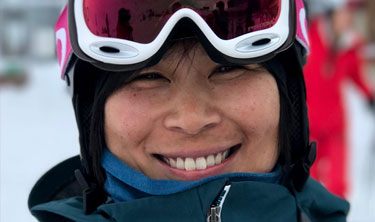A Technical Tip by Yukiko Kawada
Riding in harmony with the terrain, and using the whole mountain as a playground is the ultimate goal for many riders. When this is working, the rider receives information from the environment (snow conditions, type of slope, etc.) to determine how to ride efficiently, fluidly, and working in sync with the terrain. This allows a rider to be more independent; being able to explore the mountain on his/her own. It also promotes fun part and freedom of snowboarding!
As an instructor, you can promote this type of riding and learning using the following concept. There are 4 steps…
- Read: Observe the terrain visually.
- Feel: Receive information from the terrain using your various senses.
- React: Determine what needs to be done to ride without fighting or forcing movements, and being more efficient in harmony with terrain. Movements match the information coming from the terrain.
- Proactive: When a rider becomes more experienced and comfortable with the first three steps, this will be the ultimate stage to add performance.
This concept applies any level of riders, from beginner to expert:
Example 1: An intermediate rider tries riding powder snow for the fist time.
- Read: Snow surface, the amount of powder snow, steepness of the run, line visibility etc.
- Feel: Speed (slow or fast?). Board floating on snow? Nose of the snowboard diving or not?
- React: Too slow – keep the board pointing downhill more to gain speed, make less turns. Use less edge to float, shift weight slightly back to keep nose of the board up. Too fast – direct the board across the slope more to reduce speed.
- Proactive: Once the React stage has been achieved, increase the performance or “fun factor” by pumping the board, taking different lines, playing with turn size and shape, etc.
Example 2: An expert rider on a steep, smooth surface with chalky, firm snow.
- Read: Snow surface, steepness, visibility light, lines, contours, etc.
- Feel: Is the edge gripping the snow? Is the snow surface as smooth as it looked, or not.
- React: Keep upper body relaxed and quiet, focus on edge grip to start and finish the turn, keeping snowboard in contact with snow. Be smooth and controlled (not explosive) but with firm pressure application throughout the turns.
- Proactive: Determine next move immediately after each turn, keeping speed and rhythm.
Example 3: Beginner rider learning to improve direction change (pendulum).
- Read: Which direction is the fall line? What is the snow surface like? Any obstacles, traffic, etc.?
- Feel: Where is my board directing? Am I in control?
- React: Control the direction by applying more edge angle and more pressure. Maintain a relaxed and balanced body position.
- Proactive: Increase the travel distance, speed, the amount of movements, etc.
As you can see from all the above examples, this concept can be used by any level of rider, and can be a very useful approach to introduce. Technical knowledge will help a rider to determine what to do and when to do it to allow them to preform precisely. Although this approach will be another key for improving a rider’s riding skills, it will also help them to discover (or re-discover) the fun and creativity of snowboarding. Developing the skill of “feel” in snowboarding is very important, as a rider always needs to communicate with terrain when snowboarding.
Enjoy!
Yukiko Kawada
National Technical Team Member
Whistler, BC
